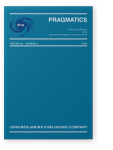Vol. 30:4 (2020) ► pp.509–531
Pragmatic functions of I think in computer-mediated, cross-cultural communication between Taiwanese and Japanese undergraduate students
This study explores the functions of I think in synchronous, computer-mediated cross-cultural communication of Japanese and Taiwanese university students. The data used in this study were collected from the Cross-Cultural Distance Learning corpus, which contains transcriptions of recorded synchronous spoken and written interactions between Taiwanese and Japanese university students. To examine the functions of I think, occurrences of the phrase were screened, analyzed, and categorized based on collocation pattern, discourse context, and sequentiality. The Taiwanese students showed a greater tendency to use the various functions of I think in discourse than the Japanese students, who rarely used its functions in their online cross-cultural communication. The results suggest that their respective perceived conversation strategies may be a significant cause of variation in the frequency of use of I think functions.
Article outline
- 1.Introduction
- 2.Pragmatic functions of I think
- 3.Methodology
- Criteria for analyzing I think
- Collocation patterns
- Discourse contexts
- Sequentiality
- Criteria for analyzing I think
- 4.Findings
- 4.1Overall frequency of I think
- 4.2Comparison of distribution of I think
- 4.2.1Evaluative ‘I think’
- 4.2.2Emphatic ‘I think’
- 4.2.3Tentative ‘I think’
- 4.2.4Discursive ‘I think’
- 4.2.5Mitigating ‘I think’
- 5.Discussion
- 6.Conclusion
-
References
